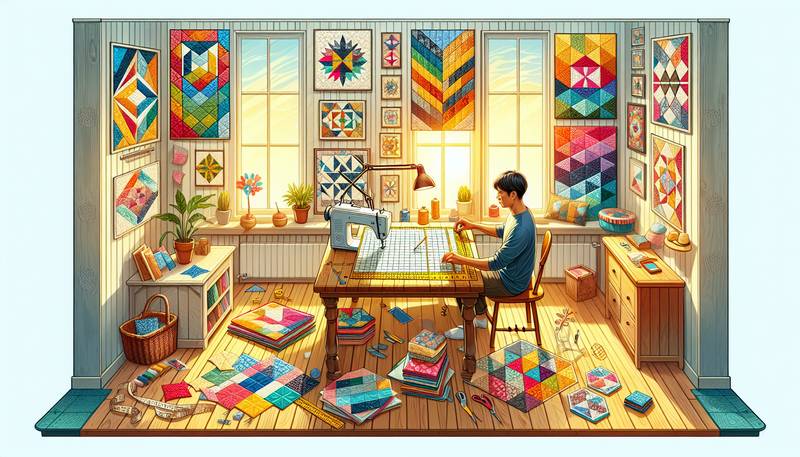Learning Geometry Through Quilt-Making

Stitching Together Shapes and AnglesGeometry may seem as relatable as a three-legged cat on a tightrope, but it does have its perks, especially when it finds its way into the cozy world of quilt-making. After all, what better way to engage with the angles of triangles and the curves of circles than through the art of sewing? It's like finding a secret passage in a boring textbook, leading you straight into a room filled with patchwork patterns and a delightful aroma of fabric softener.Imagine cutting squares, triangles, and hexagons, all while secretly plotting to bring those playful shapes to life in a quilt. As a quilter, you’ll soon realize that geometry isn't just something you doodle in boredom during math class; it's your new best friend, ready to help you create stunning designs, all while keeping your brain sharp enough to slice fabric with precision.A Not-So-Rough Cut at Geometry BasicsBefore diving headfirst into the fabric jungle, let’s run through a few geometric essentials that will transform you into a fabric wizard. Knowing your shapes is crucial—after all, you can’t just conjure a masterpiece from a series of unfortunate fabric swatches! Here are some basic shapes you’ll encounter: - Squares: The bread and butter of quilting, squares form the backbone of most quilt designs. They’re like the dependable friend who always has your back.
- Triangles: These cheeky little shapes add flair and can be stitched into magnificent designs like the ever-popular pinwheel. Just be careful; if you treat them wrong, they might turn into a real headache!
- Rectangles: A classic and versatile option. They hold a soft spot in the hearts of inexperienced quilters who often confuse them with their square cousins.
- Hexagons: These six-sided wonders are like the popular kid at school who’s just effortlessly cool. They create stunning patterns that can make anyone feel like a quilting genius.
Mastering these shapes will not only make you the Picasso of patchwork but also turn you into a geometry enthusiast—if only for the duration of the project, of course.Measuring Up to PerfectionThe dreaded measuring tape! It stares at you, mocking your uneven seams and lopsided cuts. But fear not! Embracing the art of measuring transforms you from a whimsical dreamer into a quilting pro. Remember, angles are only as sharp as your ruler, and no one wants a quilt that resembles a wonky funhouse mirror.Accurate measurements ensure that each piece fits together seamlessly—like peanut butter and jelly, or socks and sandals (well, maybe not that last one). Keep your measuring tape handy, and don’t forget to double-check those dimensions. The last thing you want is to get to the end of your project only to find you’ve created an accidental modern art piece instead!Quilt Designs: Where Geometry Gets FabulousOnce you have a handle on your shapes and measurements, it’s time to unleash your creativity. The beauty of quilt-making lies in its ability to combine geometry with sheer artistry. Each block you stitch can tell a story, and the configuration of those blocks can turn simple shapes into breathtaking designs.Some popular patterns that dance through the geometrical realm include: - Log Cabin: A classic! The log cabin design is the ultimate geometric twist, wrapping around the center like a cozy blanket of nostalgia.
- Nine Patch: This pattern is the best friend's invitation to geometry—a perfect square that shows off your skills without being too demanding.
- Bargello: It’s like a rollercoaster ride through color and shape, where curves and lines mix to create mesmerizing visual waves!
The combination of geometry and creativity leads to a delightful quilt that’s sure to impress not just friends and family but also your neighbor’s cat, who undoubtedly has the most discerning taste.Cross-Stitching Your KnowledgeCombining geometry and quilt-making can feel like piecing together a jigsaw puzzle in a dark room—but the moment all the shapes lock into place is pure magic. You discover the joy of creating something beautiful while flexing your mathematical muscles. It’s a win-win situation!So, whether you’re creating a cozy comforter or a whimsical wall hanging, remember: every stitch is a celebration of your newfound geometric prowess. And while those angles may seem daunting, they can lead to beautiful results that may just inspire you to take on the world—or at least tackle the next quilt project.Patchwork Puns and Final ThoughtsAs you embark on this geometric journey through quilt-making, relish in the laughter and challenge that comes with it. Each miscut and faux pas is just another stitch in the quilt of life (yes, pun intended). So, as you dive into your next project and measure out your fabric, remember that geometry might not always be a square deal—but with the right angles, you can definitely sew it up beautifully!
|
|







